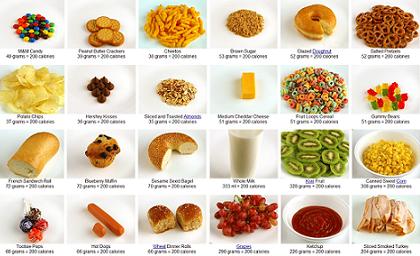The body needs energy to fuel its metabolic and physical activities. Three nutrients, carbohydrate, protein and fat, can provide energy to the body. Alcohol is not a nutrient, but it also provide energy when metabolized by the body. In addition to providing energy carbohydrate, protein and fat build have other roles in building and maintaining body tissues and regulating body functions. Vitamins, minerals and water do not provide energy.Calories are a measure of the amount of energy provided from food. Fats provide nine calories per gram, and carbohydrates and proteins provide four calories per gram.. Alcohol provides seven calories per gram. The amount of energy a food provides depends on how much carbohydrate, far and protein in contains. Most foods contain all three of these nutrients, as well as vitamins, minerals, water and other compounds.
Individuals have different calorie needs. A 6-foot teenage boy playing high school sports may need 3,000 calories a day, whereas a petite female may only need 2,000 calories a day. Calorie needs may vary even day to day for an individual. Someone who usually sits at a desk for 6 to 8 hours per day would need more calories if they were physically active on the weekends.
Calorie balance occurs when calories IN = calories OUT. If calories IN is greater than calories OUT, weight gain occurs. If calories IN is less than calories OUT, weight loss occurs. There are approximately 3,500 calories in one pound of body fat.
An individuals’ calorie needs are a combination of their calorie needs for basal metabolism, calorie needs for physical activity, and calorie needs for the digestion and metabolism of food. Basal metabolism accounts for about 60% of the body’s total calorie needs. Physical activity accounts for about 30% of the body’s total calorie needs. For very physically active individuals physical activity may account for up to 40% of calorie needs. Digestion and absorption of foods accounts for about 10% of calorie needs. The following is a one way to estimate calorie needs.
Estimating Daily Calorie Needs
1. Estimate basal metabolism calorie needs
a. Women
______ weight in pounds X 10 = ______ basal metabolism calories
b. Men
______ weight in pounds X 11 = ______ basal metabolism calories
2. Estimate physical activity calorie needs
Intensity level Physical Activity Factor
Very Light 20% (0.20)
Light 30% (0.30)
Moderate 40% (0.40)
Heavy 50% (0.50)
______ basal metabolism calories = physical activity calories
X ______ physical activity factor (%)
= ______ physical activity calorie needs
3. Estimate calories needs for basal metabolism and physical activity
______ basal metabolism calories
+ ______ physical activity calories
= ______ calories needs
4. Estimate calories for digestion and metabolism of food
______ calorie needs
X 10% (.10)
= ______ digestion and metabolism calories
5. Estimate total calorie needs
_____ basal metabolism calories
+ _____ physical activity calories
+ _____ digestion and metabolism calories
= _____ Total Calorie Needs
Remember, calories are the natural anabolic when it comes to building muscle.
